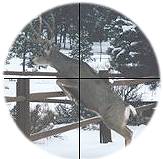Before the pioneers of America arrived, there were more than 30,000,000 whitetails in what is now the U.S. and Canada. By the year 1900, only 400,000 remained. Since then, one of the most dramatic success stories in conservation history occurred. The whitetail population has since then been rebuilt to over 20,000,000.
Nonetheless, the conservation battle is far from over. Today, whitetails face a new danger: the loss of their habitat. Pine forests in the Southern U.S. are being damaged by controlled fires, as well as naturally ocurring fires. This prevents the forest from getting thick enough to help nurture undergrowth that the deer need for food.
In Northern forests, damage is done by logging and herbicides. Also, controlled fires are used which damages the forests even more. There are efforts being made to accomodate the deer such as rotating cattle to give the deer grazing land. Also, conservation groups have purchased many of the wetlands and other natural habitats for deer.
Still, this may not be enough. In some areas, deer become overpopulated, especially in heavy agricultural areas. They cause many traffic accidents, and also damage gardens and valuable crops. When hunting is allowed, these problems are not as severe. In some areas there is increasing antihunting sentiments created by some animal-rights and environmental groups. This presents a serious threat to the sport. Many of these nonhunters do not realize that whitetail restoration efforts are financed by the sales of hunting licenses and the taxes placed on hunting
equipment.
Do your part by participating in programs that encourage responsible hunting. Join a sportsman's club or some kind of conservation organization as this will help pay for the development of deer habitat and emergency feeding projects. |

